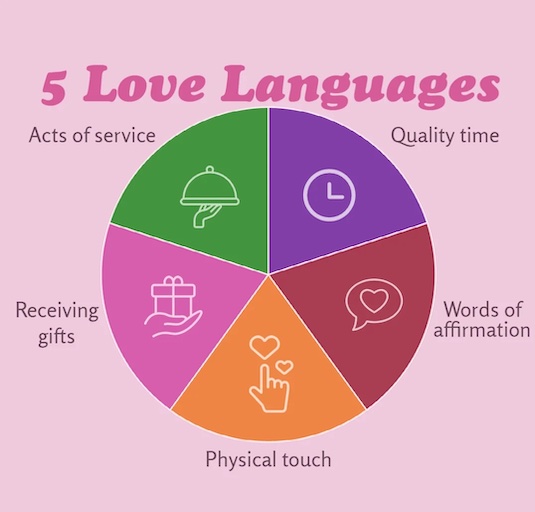
Understanding Love Languages
What are Love Languages?
Love languages refer to the unique ways individuals express and receive love. Developed by Dr. Gary Chapman, these languages include:
- Words of Affirmation
- Acts of Service
- Receiving Gifts
- Quality Time
- Physical Touch
Each person has a primary love language that influences how they connect with others. For instance, someone whose love language is Physical Touch may feel most appreciated through hugs or hand-holding.
Importance of Love Languages in Relationships
Understanding love languages is essential for fostering deeper connections. When partners speak each other’s love languages, they feel valued and understood, leading to healthier communication and less conflict.
Consider a couple where one partner thrives on words of affirmation. If their partner expresses love mainly through acts of service, misunderstandings may arise. Recognizing and adapting to each other’s love languages can transform a relationship, enriching emotional intimacy and affection.

Identifying Your Partner’s Love Language
The Five Love Languages Overview
As relationships evolve, identifying your partner’s love language becomes crucial. The five love languages include:
- Words of Affirmation: Verbal expressions that uplift and affirm.
- Acts of Service: Actions performed to help or please.
- Receiving Gifts: Thoughtful presents that show care.
- Quality Time: Undivided attention and shared experiences.
- Physical Touch: Affectionate contact that conveys love.
Understanding these can greatly enhance the emotional bond between partners.
Signs to Recognize Each Love Language
Recognizing your partner’s love language may require observation and conversation. Here are some signs:
- Words of Affirmation: They light up when you compliment them.
- Acts of Service: They often express appreciation for your help.
- Receiving Gifts: They enjoy surprising you with little presents.
- Quality Time: They prioritize spending time together over other commitments.
- Physical Touch: They frequently initiate hugs or cuddles.
By being attentive to these cues, couples can bridge the gap in their communication and strengthen their connection.

Strategies for Dating Someone with a Different Love Language
Communication Tips
When dating someone with a different love language, effective communication becomes vital. Openly discuss your love languages to understand each other’s needs. Here are some helpful tips:
- Ask Open-Ended Questions: Inquire about what makes each other feel loved.
- Share Your Experiences: Talk about past relationships and how you expressed love.
- Be Patient: Understand that adapting takes time; practice and willingness are key.
Engaging in this dialogue can reveal a wealth of insights into your partner’s emotional landscape.
Tailoring Gestures and Actions
To express love genuinely, tailor your gestures based on their language. For instance:
- If their love language is Acts of Service: Surprise them by doing chores or running errands.
- If they appreciate Quality Time: Plan special outings that allow for meaningful connection.
- For Physical Touch lovers: Hold hands when walking or offer spontaneous hugs.
By consciously adapting your actions, you reinforce your commitment to understanding and cherishing your partner, creating a more harmonious relationship.

Overcoming Challenges in a Relationship with Different Love Languages
Common Misunderstandings
Navigating a relationship where partners have different love languages can lead to misunderstandings. For example, one partner may frequently express love through acts of service, while the other craves words of affirmation. This discrepancy can result in feelings of neglect.
To overcome this, it’s essential to:
- Recognize Differences: Accept that each partner has unique needs.
- Avoid Assumptions: Don’t assume your partner knows how you feel; communicate openly.
- Reflect on Reactions: When hurt, think about what love language might be at play.
Compromise and Adaptation
Finding a middle ground is key to fostering a harmonious relationship. Compromise involves both partners making small adjustments to meet each other halfway. Here’s how:
- Create a Blend: Incorporate elements of both love languages in your routine. For instance, if one appreciates words of affirmation and the other values quality time, spend an evening together expressing affirmations during a shared activity.
- Set Goals Together: Work on small strategies, such as setting aside specific times for quality conversations or acts of service.
- Practice Forgiveness: Understand that mistakes will happen; it’s about learning from them together.
By being adaptable and setting mutual goals, couples can overcome challenges and cultivate a deeper connection.
:max_bytes(150000):strip_icc()/Health-LoveLanguages-V2-693dc581ca95494eaf2da6dc026c9040.jpg)
Building a Strong Connection with Diverse Love Languages
Finding Common Ground
To strengthen a relationship with differing love languages, it’s important to identify and focus on common ground. This begins with:
- Shared Activities: Engage in activities both partners enjoy, such as cooking together or exploring a new hobby.
- Mutual Appreciation: Regularly express gratitude for each other’s efforts when it comes to love languages. This can enhance feelings of connection and show respect for each other’s styles.
By consciously working together on shared interests, couples can foster a deeper bond.
Celebrating Differences in Love Languages
Embracing the differences in love languages can be enriching rather than divisive. Couples should:
- Explore Each Other’s Languages: Take time to learn about and practice each other’s love languages. For instance, if your partner values gifts, surprise them with a thoughtful gesture.
- Share Stories: Discuss what each love language means to you. Personal stories can create understanding and bridge gaps.
- Host Love Language Days: Dedicate days to focus on each other’s love languages, celebrating the unique ways you can express affection.
By viewing differences as opportunities rather than challenges, couples can create a vibrant, supportive relationship that fully appreciates the beauty of diversity in love languages.

Conclusion and Final Thoughts
Embracing Diversity in Love Languages
Embracing diversity in love languages can transform relationships into something truly special. Every love language brings its own flavor, enriching connections in ways that deepen bonds and enhance emotional intimacy. A couple that understands and appreciates their differences can thrive together.
- Celebrate Unique Styles: Appreciate how your love languages complement each other.
- Curiosity as a Tool: Stay curious about your partner’s preferences and needs.
This celebration of diversity fosters a supportive environment where love can flourish.
Importance of Effort and Understanding
Ultimately, the most valuable aspect of navigating different love languages is the effort put into understanding one another. It requires:
- Consistent Communication: Regularly check in on each other’s emotional needs.
- Flexibility: Be willing to adapt and grow as a couple.
- Commitment: Stay dedicated to learning and improving your relationship.
By prioritizing effort and understanding, couples can build a lasting connection that not only survives but thrives amidst their unique love languages. This commitment can lead to a more fulfilling and enriching partnership.
